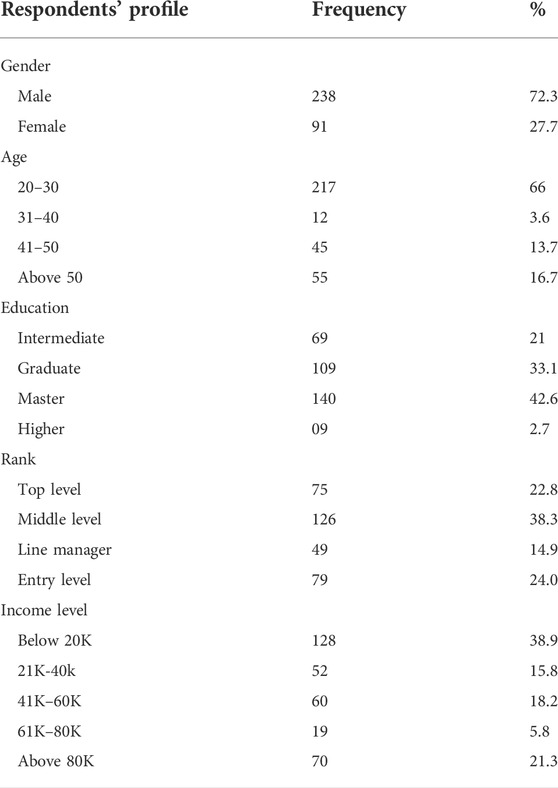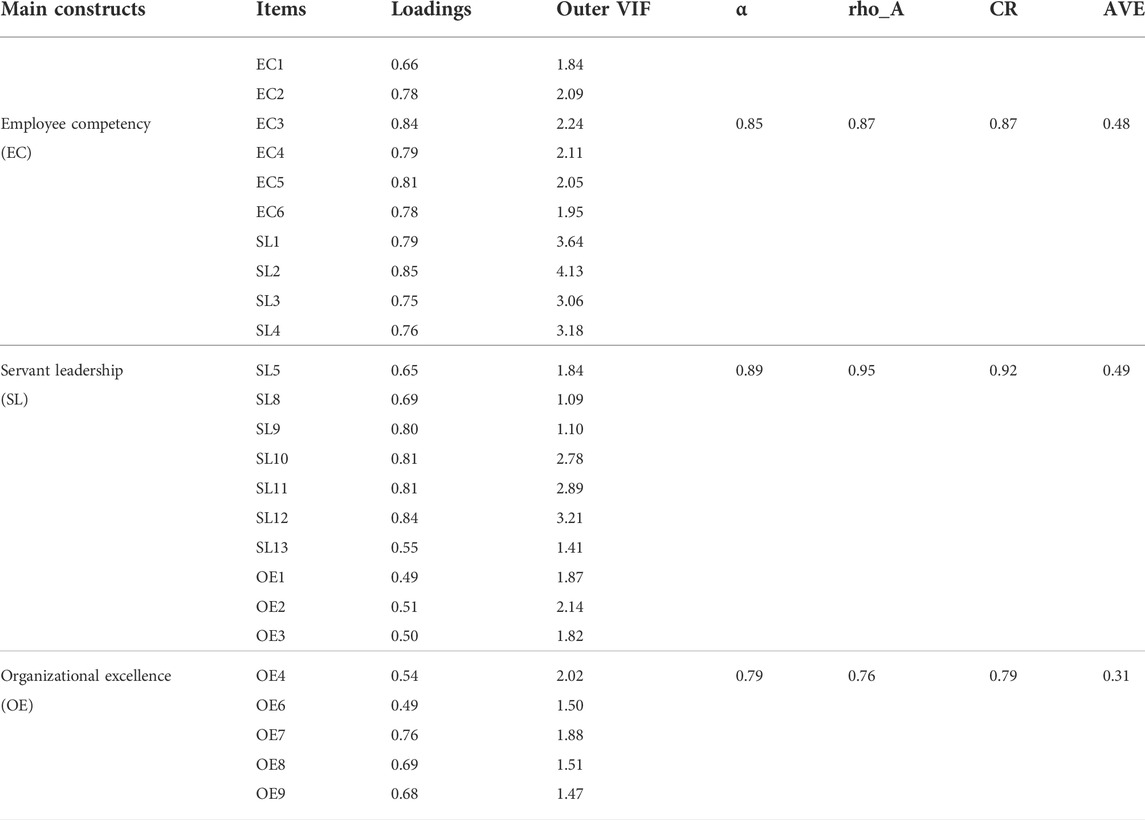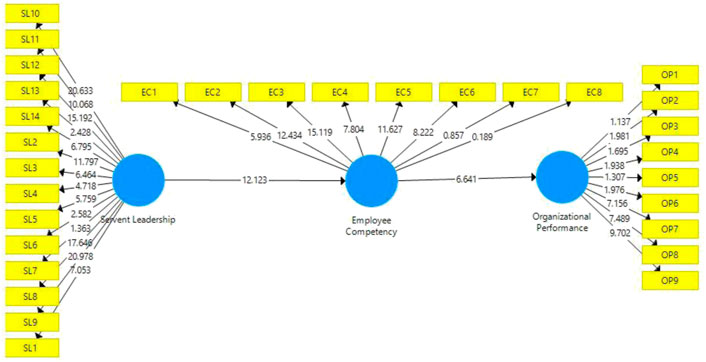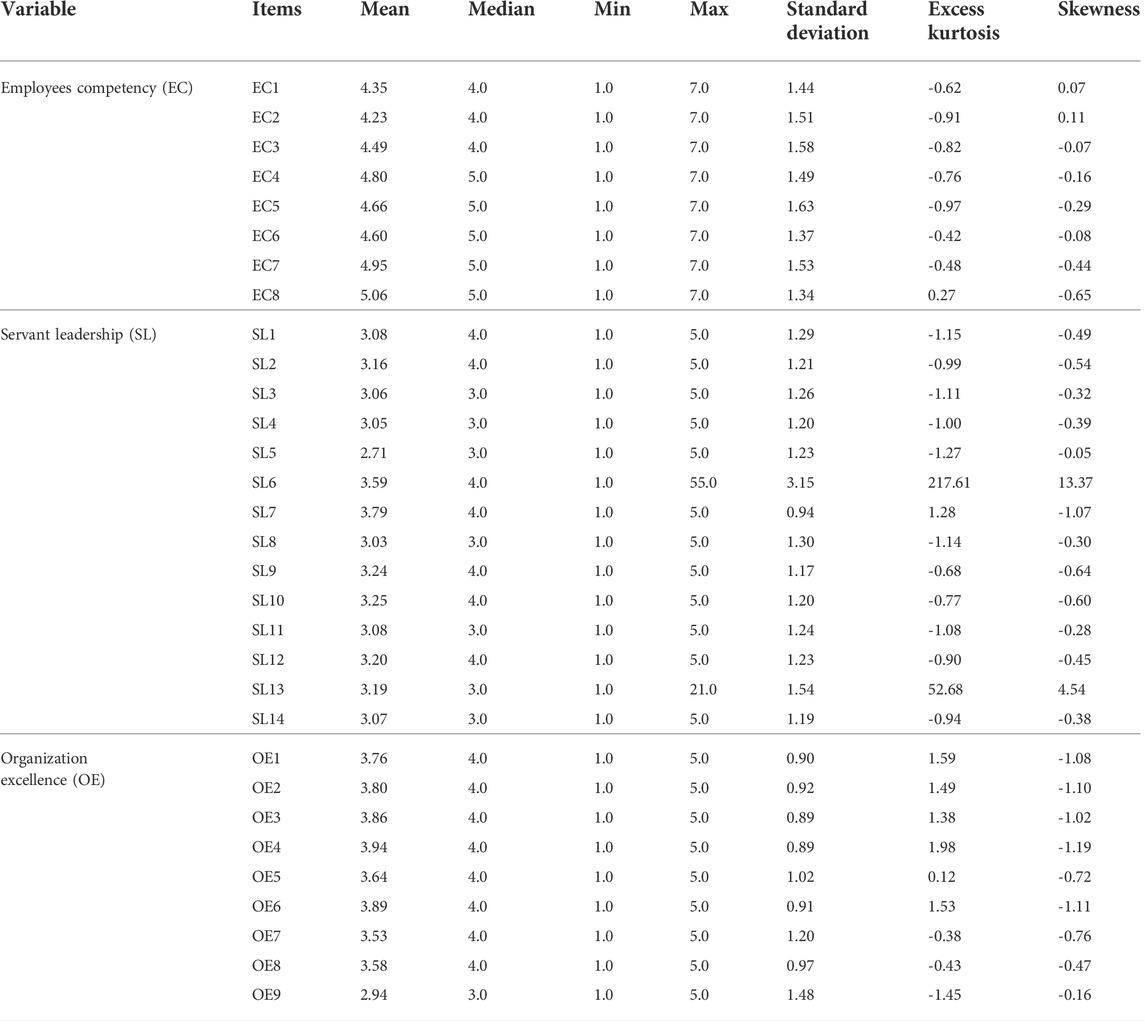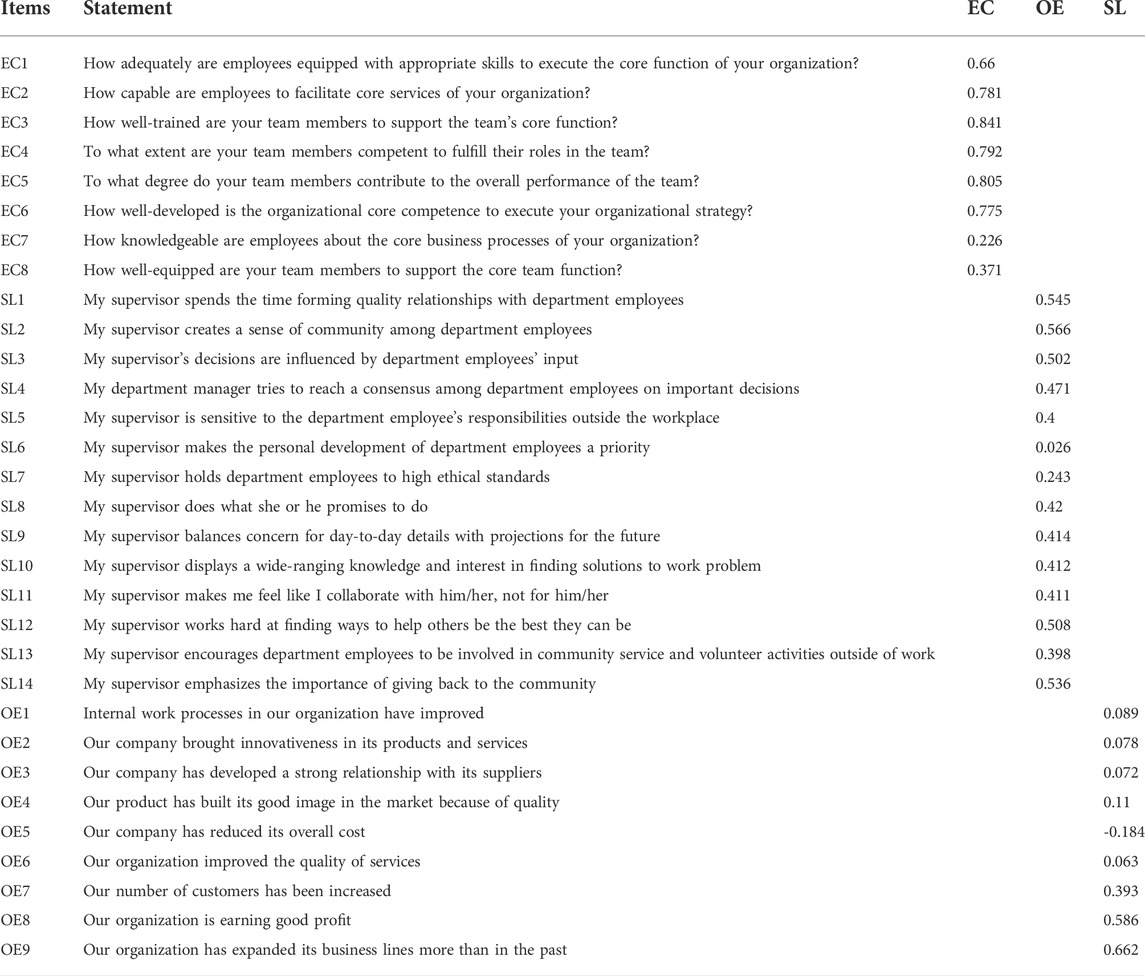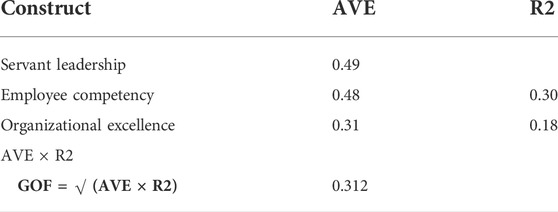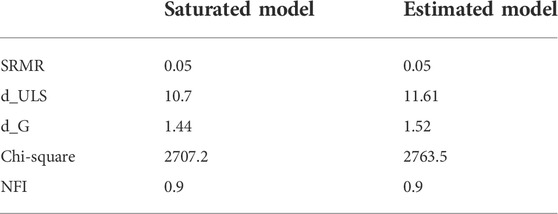- 1Institute of Banking and Finance, Bahauddin Zakariya University, Multan, Pakistan
- 2Department of Management Information Systems, College of Business Administration, Prince Sattam Bin Abdulaziz University, Al-Kharj, Saudi Arabia
- 3Department of English, National University of Modern Languages, Multan, Pakistan
- 4UE Business School, Division of Management and Administrative Sciences, University of Education, Lahore, Pakistan
- 5Department of Human Resource Management, College of Business Administration, University of Jeddah, Jeddah, Saudi Arabia
The role of leadership in an organization’s parameters has been enhanced, especially in an uncertain environment. New environmental and sustainability laws and social responsibilities are emerging. Corporates are making continuous efforts to be sustainable and excellent in their performance. The purpose of this study is to measure the impact of servant leadership on organizational behavior when work capacity mediates this relationship from a cross-cultural perspective. We created a three-variable survey containing 31 items to collect statistics on 329 employees in the Pakistan, China, and Saudi Arabian corporate sectors. It was a structured, quantitative study. Cross-section procedures have been implemented to gain experience. The conclusions of the study show that employee competence is an intermediary between servant leadership and organizational performance. Servant leaders make a positive difference in an organization’s excellence. This study suggests the practical importance of servant leadership and employee competency in the cross-cultural corporate sector. This study influenced the concept of servant leadership in corporate philosophy. Future studies may be directed to finding the relationship through more complex and rigorous research designs.
1 Introduction
Leadership has always lived in a debate that meets the needs of others, has a unanimous vision, and has instructed development. Also, the concept of leadership has always been questionable, despite many adjustments. This theory has been studied several times, but there are still some practical shadows that need to be dealt with (Gupta et al., 2005). The style of leadership has changed from authoritarian to participatory. Dictatorship and listings follow, but ideally servant leadership. The concept of servant leadership has emerged in the market, and this view is temporary and has practical reliability (Greenleaf, 1998). Internal dynamics and philosophy have created a demand for servant leadership. The decision-making and service-oriented approach is the path to organizational wisdom, which is defined as a fusion of applied wisdom and hindsight experience for both maximized and philanthropic choices (Bierly et al., 2000). The concept of leadership promotes empowerment, teamwork, participatory management, and work ethics. Servant leadership helps others improve to achieve common goals (Page and Wong, 2000). Employee skills and work experience motivate employees to achieve their company’s goals (Ikinci, 2014). Managers play a vital role in every organization. Why are executives viewed as the backbone of business? The author emphasized this aspect. As a result, the corporate sector has changed several times due to rapid development of its business. Therefore, it has encouraged researchers to explore new concepts of leadership. Researchers have begun looking for leaders who have a positive approach to their organization’s success. The approach of the leader determines the course of the organization. If your organization has a structured leader, an accurate and expected approach will work.
We consider the talented people of an organization to be the best source of competitive advantage for any organization. Competitors can mimic products, services, and other intangible strengths, but talented people are difficult to attract. Motivated and talented employees are a bonus to every organization. There is a need in the corporate world for talented people. The global market requires companies to become more efficient and flexible in this evolving corporate world. Flexibility and careful decision-making are a matter of time. Managers must communicate this decision to the workers on the ground. This is the time it takes to identify human resource practices that improve the organization’s performance.
Talent is individual ability or capability (Boyatzis et al., 2005). However, it has been defined as the ability and efficiency as a set of knowledge, skills, attitudes, intellect, and perspectives of one’s interests to perform tasks efficiently and effectively. This is the way of working (Rossilah, 2008). Competence is a fundamental characteristic that is a key factor for success at work. An organization needs to ensure that its employees have the knowledge, skills, and attitudes about business goals, objectives, and values (Calhoun et al., 2008). Furthermore, individual beliefs, motives, social status, and abilities form an individual’s competence diaspora (Boyatzis et al., 2005). Knowledge and skills merged into competencies. In 2001, several studies were conducted to determine competencies. The survey lasted 15 years and surveyed data from 60 companies. According to a survey, for companies that hired quality employees, the achievements and work ethics were high (Bhardwaj and Punia, 2013).
Companies across the globe are struggling to adopt the best suitable leadership styles. The companies in Pakistan, China, and Saudi Arabia being the working companies in the eastern cultural region are facing challenges for growth. Employees’ talent and challenging work may play a key role in achieving their organizational excellence. Organization excellence is measured in terms of better services, products, and customer services. Somewhere, the Eastern context of these companies becomes necessary to be investigated due to cultural homogeneity among them and cultural heterogeneity from the Western countries. Today, organizations put people first and are looking for leaders who do not abuse their power. Furthermore, it has been emphasized that organizations with leaders servicing people have more satisfying, loyal, and well-performing employees. Modern evidence of this phenomenon is called servant leadership (Liden et al., 2000). This way, one can immediately serve the organization’s personnel. Employee leaders consider employees a top priority. They thank employees for their feedback and appreciate their work. This study seeks to bridge the gap in the research, with a focus on profitable public and private sector organizations, to find a relationship between employee leadership and organizational performance. Several types of studies support the claim that servant leadership can improve organizational performance (Baykal et al., 2018). However, the intermediate impact of measuring an employee’s ability to organizational performance and servant leadership in a company is inherently new. Similarly, there is less focus in the literature investigating the intermediary role of employee competence between employee leadership and organizational performance. The current study aims to investigate the positive impact of employee leadership on organizational performance. Similarly, it measures the intermediary role of employee competence between employee leadership and organizational performance. In our research, we raised two research questions.
Q1: Does servant leadership directly influence organizational performance in a cross-cultural perspective?
Q2: Does employee competency play a mediating role between servant leadership and organizational excellence in a cross-cultural perspective?
2 Conceptual model
This section describes the proposed impact of servant leadership on organizational performance and the role of employees’ abilities as intermediaries. Furthermore, this section describes the design and assumptions of the study. Hypotheses and study designs provide key points throughout the literature review. We obtained the servant leadership concept from a study “The power of servant-leadership: Essays” (Greenleaf, 1998). The essence of servant leadership is to serve your subordinates. The first thing servant leaders must consider is their instinct to serve. A quiet feature that distinguishes servant leaders from other leaders is that they prioritize meeting people’s needs (Gordon, 1977). They promise to serve the interests of their subordinates with the highest priority. Different schools deny the concept of servant leadership because according to them, the two are inconsistent with each other, whether they are leaders or servants. They cannot play two roles at the same time (Greenleaf, 1998). The relevant skills of servant leaders are their powerful ability to integrate leadership and services and provide motivation (Trompenaars and Voerman, 2009). Unique features of servant leaders are positivity, humility, and compliance with organizational performance (Owens and Hekman, 2012). Subordinates consider servant leaders to be role models for their integrity and personality (Lord and Brown, 2001).
Employee abilities focus on the employee’s characteristics and skills. These skills are unique and can be distinguished from poorly performing employees. Organizational capacity is called eternal organizational value, and its essence is permanent and has nothing to do with employee mobility. Talented employees in high-performance organizations have basic talents, skills, and the ability to express their opinions (Antwi et al., 2019). These employees are very loyal to the organization. They do not change the organization but follow the organization. Their performance reaches its highest level of educational training provided. Employee capabilities determine the performance of an organization. Organizations can improve their employees’ competencies through powerful training programs. After acquiring relevant talents, skills, and attitudes, they can complete their existing work more effectively and efficiently (Wright and Geroy, 2001). Talented and motivated employees in any organization are the best source of its competitiveness. Competitors can copy products, services, and other intangible core competencies, but it is difficult to attract talented employees. Employee skills and characteristics are unique and difficult to imitate.
Organizational performance can be defined as achieving elevated levels of goals at the individual and administrative levels through certain types of multipart activities (Farman et al., 2019). A few years ago, Business Science Friendship defined the characteristics of leaders as a benchmark for victory in the field of instantaneous change and development of management and science introduced servant leadership. A servant leader is the first servant (Greenleaf, 1998). It starts with the instinct to serve. Since then, a conscious choice is aimed at leadership (Spears, 2010). Servant leadership is worth noting in terms of improving organizational performance (Olesia et al., 2013). The study found a positive correlation between servant leadership and organizational performance. In this relationship, servant leadership often enhances organizational performance (Jones et al., 2012). Also, similar results were observed as it is speculated that leadership will have a positive impact on the organization and will produce positive results (Bass, 2000) and because employees actively respond to employee leadership (Baykal et al., 2018). Inconsistent with the aforementioned studies, servant leadership can improve the performance of companies (Peterson et al., 2012). Based on the literature, we proposed the following model to be tested with rigorous data.
Hypothesis 1. (H1). Servant leadership has a positive impact on organizational excellence.
Hypothesis 2. (H2). Employee competency has a positive impact on organizational excellence.
Hypothesis 3. (H3). Employee competency meditates between servant leadership and organizational excellence.
3 Research methods
We conducted the study in the enterprises of the hospitality industry. This was a causal study coming under the quantitative paradigm. We adopted the mixed-mode surveys (physically as well as online-administered) method. This method has been proven effective in compensating for the weakness of different survey methods for collecting accurate data from the respondents (Van Selm and Jankowski, 2006; Dillman, 2011). In one phase, we sent an online survey built on Google forms to the managerial employees on their Emails, WhatsApp, and Facebook to collect the data. Many reminders were given to fill in the survey. The online survey is time-saving, cost-effective, and can be conducted remotely reducing the geographic constraint (Evans and Mathur, 2005; Sue and Ritter, 2012; Dusek et al., 2015). In the other phase, we visited the offices of the respondents and asked them to fill it in person. The survey method has gained importance for collecting data from a large cohort. The survey questionnaire was composed of two parts. The first part collected demographic information such as age, gender, qualifications, income, and designation of the respondents. The second section contained a Likert scale ranging from 1–5 (1 strongly agree to 5 = strongly disagree, with 3 being a neutral feeling) to measure servant leadership, employee competence, and organizational excellence. The Likert scale has gained popularity in collecting reliable and valid data by forcing respondents on a close-ended scale of psychometric constructs (Likert, 1932; Schuman et al., 1981; Krosnick, 1999). The questionnaire contained three variables (servant leadership, employee competence, and organizational performance/excellence) and 31 items. We used a 14-item scale to measure servant leadership (Ehrhart, 2004). For employee competence measurement, we adopted a scale consisting of eight items (Jacobs and Roodt, 2019). Also, the study used a nine-item organizational excellence scale (Al-Gamrh et al., 2020). Data were collected in 3 months from Pakistan, China, and Saudi Arabia. It is worth mentioning that all our respondents participated in the survey of their own free will. We included all the valid responses given in the table below in the data analysis.
The study adopted a mixed-method sampling design using convenient sampling and snowball-sampling techniques to reap wider benefits of sample validity (Valerio et al., 2016). We collected 329 completed questionnaires from a sample of 400 managers. The sample size was appropriate as suggested in the literature (=items in the scale*10) (Lohr, 2010; Blair and Blair, 2014). Their appointments ranged from middle to top managers. Similarly, their qualifications ranged from graduation to Ph.D. and their ages were 20–50 years.
4 Data analysis
The Table 1 mentioned above is a sample isolated from this study. We collected 329 responses from different ages, income levels, qualifications, and job titles. The sample data show that 72.3% of respondents are male. On the other hand, females make up only 27.7% of the total population. This demonstrates that there is a relatively low level of female engagement in organizations in Pakistan, China, and Saudi Arabia. Most people who participated in the survey were between the ages of 20 and 30. It is reassuring to see that the countries’ population is predominantly made up of young people, which is a healthy indicator. In addition to this, 45% of respondents hold at least a master’s degree or an M. Phil. This is an encouraging sign. It is possible to conclude from this sample that businesses in the countries are looking for people with a prominent level of qualification. The people who agreed to be interviewed on our behalf had elevated levels of education. In terms of the organizational structure, 38.3% of the respondents came from the medium level of the hierarchy. It is worth mentioning that the respondents represent all levels. In the income class, most respondents were under the age of 20.
The details that have been highlighted previously provide evidence that our sample meets the requirements. Many people in the sample reflect the variety of responses. This sample has become more reliable and inquisitive because of the responses received from a variety of companies, including public and private ones, as well as the responses provided by academicians. In addition, respondents were given explicit instructions to follow to minimize the possibility of social prejudice (Podsakoff and Organ, 1986). In addition, this study followed the comments to make the sample more accurate and constructive (Jarvis et al., 2003). It was made clear to everyone who participated in the survey that their identities will be kept confidential. The names of the dimensions and variables were not explained to the respondents to elicit replies from the participants who were honest and spontaneous. Similarly, it was made clear to the participants that there was no correct or incorrect response to any of the questions on the questionnaire. Data analysis was performed by using Smart-PLS, which is an increasingly famous software package to assess the data for theory-building (Lee and Yoon, 2018). It contains various useful causal functions such as path analysis, descriptions, correlations, and inner and outer model evaluations, judging the reliability and validity of the research instruments (Mohammed and Al-Swidi, 2019). Smarts are increasingly becoming popular for social science survey-based studies (Reilly and Hynan, 2014; Dutot et al., 2016). Evaluation of the model includes reliability, convergence validity, discrimination validity, and construction reliability (Ringle Christian et al., 2015).
4.1 Evaluation of the outer measurement model
4.1.1 Construct reliability and convergent validity
Structural reliability can be defined as an evaluation of the structure using the internal integrity of the index. A study pointed out that the survey indicators were uniform and could explain the survey (Blumberg et al., 2014). Traditionally, Cronbach’s alpha factor has been used to assess the consistency of the measurement items. However, Cronbach’s alpha is inconsistent because all the items it measures are equally reliable, and the indicator load is equal. In smart-PLS, the internal consistency of structural equations is evaluated with the help of composite reliability (Hair and Sarstedt, 2019). The table below shows the Cronbach alpha value and overall reliability. The Cronbach’s alpha value coefficients in this study were 0.847, 0.796, and 0.897, greater than the recommended value of 0.7 (Kannan and Tan, 2005). In addition, CR (Complex Reality) values were 0.868, 0.788, and 0.919, exceeding the 0.7 limit (Werts et al., 1974; Gefen et al., 2000; Kline, 2006). Therefore, as shown in Table 2, Cronbach’s alpha and CR are error-free for all parameters, and structural reliability is achieved.
Convergence effectiveness is a phenomenon which indicates that the response of one item is related to the response of another item (Blumberg et al., 2014). AVE (extracted mean-variance) is a good tool to measure the validity of convergence (Sarstedt et al., 2020). The ideal value for AVE should be greater than 0.5. However, convergence validity is acceptable even if the ratio of Cronbach’s alpha to composite confidence is less than 0.05 (Fornell and Larcker, 1981). The table below shows the reliability of AVE values and Cronbach’s alpha and composites.
In Table 4, the value of Cronbach alpha is greater than 0.5. The combined reliability value also matches the specified value. Therefore, these values represent the reliability of convergence.
4.1.2 Discriminant validity
The Fornell–Larcker criterion is a rigorous method for assessing discriminatory validity (Fornell and Larcker, 1981). Using the Fornell–Larcker criterion, a test has been applied. The diagonal values in Table 3 indicate the validity of the discrimination. It should be noted that, except for organizational excellence, the square root value of AVE, shown in bold diagonal, is greater than the row and column composition values. This shows the adequacy of good discrimination.
The values in Table 5 show an excellent discriminating effect. This is because the values of the variables on the diagonal are greater than the values shown in the structure. Therefore, the reliability of the discrimination is high.
4.2 Evaluation of the inner structural model
We confirmed the reliability and validity of the measurement model. The findings of the structural model are given below. The tables presented elaborately on the various aspects of the structural model.
4.2.1 Measuring the value of R2
The measure of r-square shows how much variance has been explained by the exogenous variables in the endogenous construct. This model produced an r-square of 0.018 for servant leadership to organization excellence, while the mediation of employee competency produced an r-square value of 0.30 which is quite high.
4.2.2 Estimation of path coefficients (β) and T-statistics
The evaluation of the structural model is carried out by calculating beta (β), the corresponding t value, p-value, and corresponding interval value biased by the bootloader. The values are shown in Table 4.
The results shown in Table 7 support our view that all hypotheses are significant (p < 0.05). Servant leadership has a positive impact on organizational excellence (β = 0.234, T-statistic = 5.73, and p < 0.05). Employee abilities have a positive impact on organizational excellence (β = 0.427, T-statistic = 8.714, and p < 0.05). SL also has a positive effect on EC, with values showing (β = 0.548, T statistics = 14.327, and p < 0.05). Moreover, we applied indirect impact values of 0.234, T-statistics = 5.732, and p < 0.05 to the full mediation analysis, so these numbers are positive and important. Also, the confidence interval value is non-zero, so the confidence interval deviation value meets the requirements of the directive (Hair et al., 2017). Therefore, all assumptions have been fulfilled. An arbitration test was also confirmed (Figure 1).
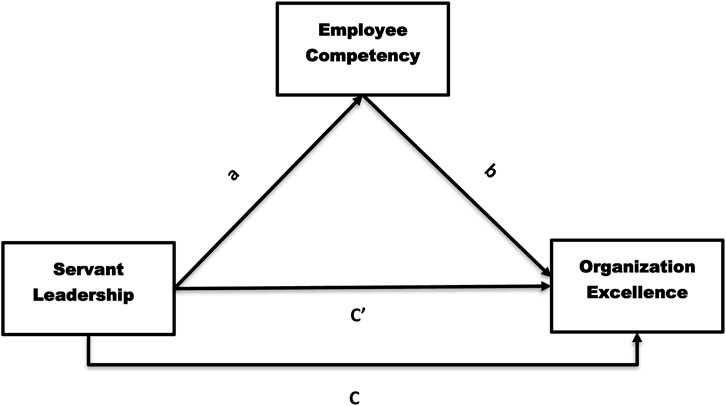
FIGURE 1. Predictive conceptual model showing the path directions for mediation, where servant leadership (X) = the independent variable, organization performance (Y) = the dependent variable, employee competency (M) = the mediating variable, a*b = the indirect effect of the mediator on Y, and C’ = the indirect direct effect of X on Y with the effect of the mediator, and C = direct effect of X on Y without a mediator.
The results shown in Figure 2 present the impact of SL on OE, and EC mediates the relationship between SL and OE. The values of r-square are significant, which means that the model is substantial. Servant leadership has a positive impact on organizational excellence (β = 0.234, T-statistic = 5.73, and p < 0.05). Moreover, SL also has a positive effect on EC, with values showing (β = 0.548, T statistics = 14.327, and p < 0.05). Additionally, employee competency has a positive impact on organizational excellence (β = 0.427, T-statistic = 8.714, and p < 0.05). These values certify all proposed hypotheses to be supported.
4.2.3 Measuring the effect size (f2)
F2 measures the effect of an individual exogenous variable on the endogenous latent construct. It changes to values of r-square when each exogenous variable is removed from the model. The r-square value largely depends on it. In our model, employee competency showed a value of 0.22, while servant leadership showed a value of 0.41, both showing a strong impact. They produced an r-square value of 0.18.
4.2.4 Goodness-of-fit index
The index shows whether the model is fit to completely explain the data. It ranges between the values of 0–1. The values close to 1 show a strong model fit and vice versa. Calculations are provided in Table 5. The table below shows the goodness-of-fit (GOF) value of 0.312, which shows a strong model fit. Our model was fit to explain and comprehensively predict the data.
4.2.5 The standardized root mean square residual
The SRMR shows the residual values between the observed and hypothesized covariance matrices. The SRMR value of 0.051 shows a good fit, which is well below the threshold value of =<0.08, while the NFI value of 0.9 is also good.
4.3 Correlation coefficient of latent variables
As a part of multi-collinearity detection, the correlation table among the latent variables is a good indicator. It has been observed that there is no genuine issue of multi-collinearity in the model. The variables are mutually exclusive from each other and were fit for further causal analysis. Furthermore, the tables show a strong connection between the exogenous and endogenous constructs.
5 Discussion and implications
In conclusion, the purpose of this study was to investigate the relationship between employee leadership and organizational excellence. The purpose of this study, which was to investigate many dimensions of servant leadership, was accomplished. The characteristics of servant leadership are distinct from those of other leadership philosophies (Graham, 1991). The conventional model of leadership is giving way to a more modern approach, which is causing a shift in the dynamics of leadership in the modern period. The idea that a leader should put the needs of their followers or employees first is gaining popularity in the current scenario. The current study took a comprehensive look at the relationship between servant leadership and the success of organizations. The capabilities of the employees might, indeed, operate as a moderator in this relationship, but it is also true that this relationship serves as a bridge between them. In each given organization, the talents of the employee’s function as an arbitrator between the various leadership styles and the level of excellence achieved by the organization. To discover the results, we developed three distinct hypotheses. To determine whether the targeted hypothesis was accurate, data were gathered from businesses operating in both the public and private sectors in Pakistan, China, and Saudi Arabia. It is interesting to note that all the assumptions are valid. The results of this study enthusiastically support the view that servant leadership has a positive impact on organizational excellence, consistent with the results of this study (McNeff and Irving, 2017). The author places a great emphasis on the role of servant leadership. Also, employee capabilities are properly mediated. The study concludes that servant leadership has a positive impact on organizational excellence. The findings have ensured one certainty that the stronger the culture of servant leadership, the stronger will be organizational excellence. This relationship is mediated by the capabilities of the employee. Employee skills, traits, and talents bring together the relationship between servant leadership and organizational excellence. The finding of this study is inconsistent (Kaur et al., 2018; Broch et al., 2020).
Moreover, the importance of servant leadership in Pakistan, China, and Saudi Arabia’s corporate sectors cannot be denied. It changes the excellence of your organization. In modern times, it is difficult to achieve organizational excellence without proper leadership. According to the research, the type of leadership has a beneficial effect on the overall performance of the organization (Mihai et al., 2017). The manner of leadership inspires employees to perform to the best of their abilities, which ultimately leads to improved organizational performance. This study was carried out at an especially valuable time; it took place during COVID-19. The findings in this article are expected to be helpful and positive for managers, practitioners, and scholars. From the manager’s point of view, this is very fruitful. It is because leadership style means a way to improve the excellence of your organization through servant leadership. The relationship is mediated by the capabilities of the employee. The country’ managers should pay attention to learning. By instilling a culture of employee leadership under the intermediate effect of employee abilities, they can achieve the desired results (Allen and Grisaffe, 2001). Managers pointed out that it is the basis of organizations that use servant leadership to motivate their subordinates. In addition to this, servant leadership clears the way for managers to focus on the tasks at hand. The task orientation encompasses the responsibilities in addition to the abilities and productiveness that are normally associated with management, such as being risk-seeking, taking initiative, and having a visionary leadership style. Servant leadership motivates leaders or managers to serve their employees, who react preemptively to their subordinates. At the same time, employee skills, traits, and talents help achieve organizational excellence (George, 2003; Boyatzis et al., 2005). The course of history demonstrates that the driving reason behind servant-leaders is their desire to shape the future in a manner that is distinct from the status quo. Long-term planning was something that united Hitler, Mussolini, and Nelson Mandela. The ambition to conduct one’s vision is one of the most striking characteristics that differentiate tyrants and servant-leaders from one another. The earlier group aggressively pursued its mission, while the latter group did the same thing, while also demonstrating understanding, compassion, and a commitment to upholding work ethics. In a word, servant leadership is not a push paradigm but rather a pull model of goal attainment (Lad and Luechauer, 1998). In addition, the current system provides leaders or managers with specific criteria to use to maximize the potential of the employees under their supervision. In addition to this, it emphasizes the significance of training for the staff members. Training that primarily focuses on improving employees’ emotional intelligence should be prioritized as a matter of particular importance for managers to organize (Goleman et al., 2002).
Similarly, the current research makes a sound and feasible contribution to the leadership literature. It has made many contributions to the business science literature. It reveals the relationship between servant leadership and employee competence and organizational excellence. Also, the ability of employees is a mediator; therefore, this study expands the scope of servant leadership. Specifically, in Pakistan, the dearth of existing literature on the subject matter has made this study more worthy. In addition, the influence that employee leaders have on the abilities, characteristics, and insights of their fellow workers has a beneficial effect on the level of organizational excellence achieved by both private and public sector businesses. As a result, the findings have significant repercussions for the executives of both public and private organizations in these countries. The firms can improve their overall productivity by providing their workers with appropriate training and by fostering a culture of servant leadership throughout the company. The cross-cultural study has wider applications and generalizability for corporations and decision-makers. The servant leadership style is best-suited to increase corporate performance and profitability overall. It will increase the employee’s job satisfaction and will send a sign of relief to the employees that their voices are being heard by the top management. The organization can reap multiple benefits by incorporating the voices of the technical people while in the stages of product development and marketing. It can enhance its sales and incorporate innovation into its product designs. The enhanced generalizability of the study is beneficial for many countries, and it will lead to the development of servant leadership theory in the field of employee satisfaction, improved productivity, and improved product designs.
5.1 Limitations
The psychological consequences of COVID-19 are the ones that may persist for the longest period and lead to a global mental health crisis. Despite making a beneficial contribution to managers and scholars, this study has some limitations. First, the leadership of servants, the capabilities of employees, and the structure of organizational excellence are adopted. There may be prejudice. Therefore, the analysis shows that the hypothesis does not have sufficient variance bias. Next, we collected data during the COVID-19 infection period. During that critical period, there was an absolute lockdown around the nations. At that period, face-to-face engagement and social get-togethers were extremely uncommon. Because of this, the psychological health of the participants at that time can be called into doubt. Studies that were conducted on COVID found that the psychological condition of people during that time was affected because of anxiety, dread, a sense of denial, and social exclusion (Ho et al., 2020). Therefore, in the future, researchers can get more accurate results by routinely collecting data. Third, because it is a cross-sectional study, we collected data at a specific point in time. So, better results can be obtained by conducting longitudinal studies in the future. Fourth, the survey was conducted in Pakistan, China, and Saudi Arabia, so the sample population was the participants from these countries’ corporate sectors. In the future, scientists may need to collect samples from other cultures for more generalizable results. Fifth, the leadership aspect of the servant is not clearly defined (Sendjaya et al., 2008; Van Dierendonck and Nuijten, 2011). In the future, research will need to clearly define aspects of servant leadership. The upcoming studies need to include multiple variables to develop a comprehensive framework. Therefore, future work should try to overcome the aforementioned limitations.
The participants in this study do not provide a diverse enough sample to meet the requirements of the current inquiry. Since the sample population comprised people who came from the same background, there is a possibility that all the participants came from the same background. In the future, a study that includes participation from both sexes equally has the potential to produce more fascinating findings. In the research (Iervolino et al., 2009), it has been shown that taking gender into account produces varied findings. Briefly, the quantitative research methodologies clarified the overall impact that servant leadership has on organizational performance. On the other hand, the qualitative study methodology might be used to collect more specific insights (Table 6, Table 7, Table 8, Table 9, Table 10).
Data availability statement
The datasets presented in this article are not readily available because the participants were ensured about the privacy of data to enhance the reliability of collected data. Requests to access the datasets should be directed to ZHIubWlyZmFuQGJ6dS5lZHUucGs=.
Ethics statement
Ethical review and approval was not required for the study on human participants in accordance with the local legislation and institutional requirements. Written informed consent for participation was not required for this study in accordance with the national legislation and the institutional requirements. Written informed consent was obtained from the individual(s) for the publication of any potentially identifiable images or data included in this article.
Author contributions
AS, MI, and AFD: conceptualization and data collection; RN, RS, and HS: data analysis and writing the draft.
Acknowledgments
The authors acknowledge MI for his support and efforts during the publication process of this manuscript.
Conflict of interest
The authors declare that the research was conducted in the absence of any commercial or financial relationships that could be construed as a potential conflict of interest.
Publisher’s note
All claims expressed in this article are solely those of the authors and do not necessarily represent those of their affiliated organizations, or those of the publisher, the editors, and the reviewers. Any product that may be evaluated in this article, or claim that may be made by its manufacturer, is not guaranteed or endorsed by the publisher.
References
Al-Gamrh, B., Al-Dhamari, R., Jalan, A., and Jahanshahi, A. A. (2020). The impact of board independence and foreign ownership on the financial and social performance of firms: Evidence from the UAE. J. Appl. Account. Res. 21, 201–229. doi:10.1108/JAAR-09-2018-0147
Allen, N. J., and Grisaffe, D. B. (2001). Employee commitment to the organization and customer reactions: Mapping the linkages. Hum. Resour. Manag. Rev. 11 (3), 209–236. doi:10.1016/s1053-4822(00)00049-8
Antwi, C. O., Fan, C. j., Aboagye, M. O., Brobbey, P., Jababu, Y., Affum-Osei, E., et al. (2019). Job demand stressors and employees’ creativity: A within-person approach to dealing with hindrance and challenge stressors at the airport environment. Serv. Industries J. 39 (3-4), 250–278. doi:10.1080/02642069.2018.1520220
Bass, B. M. (2000). The future of leadership in learning organizations. J. Leadersh. Stud. 7 (3), 18–40. doi:10.1177/107179190000700302
Baykal, E., Zehir, C., and Mahmut, K. (2018). Effects of servant leadership on gratitude, empowerment, innovativeness, and performance: Turkey example. J. Econ. Cult. Soc. 57, 29–52. doi:10.26650/jecs390903
Bhardwaj, A., and Punia, B. (2013). Managerial competencies and their influence on managerial performance: A literature review. Int. J. Adv. Res. Manag. Soc. Sci. 2 (5), 70–84.
Bierly, P. E., Kessler, E. H., and Christensen, E. W. (2000). Organizational learning, knowledge, and wisdom. J. Organ. change Manag. 13, 595–618. doi:10.1108/09534810010378605
Blumberg, B. F., Cooper, D. R., and Schindler, P. S. (2014). Business research methods. McGraw-hill education.
Boyatzis, R. E., Boyatzis, R., and McKee, A. (2005). Resonant leadership: Renewing yourself and connecting with others through mindfulness, hope, and compassion. Boston, MA: Harvard Business Press.
Broch, F. F. M., Domínguez Escrig, E., Chiva Gómez, R., and Lapiedra Alcamí, R. (2020). Promoting firm innovativeness through servant leadership and corporate social responsibility to employees. Leadersh. Organ. Dev. J. 41, 615–633. doi:10.1108/LODJ-03-2019-0127
Calhoun, J. G., Dollett, L., Sinioris, M. E., Wainio, J. A., Butler, P. W., Griffith, J. R., et al. (2008). Development of an interprofessional competency model for healthcare leadership. J. Healthc. Manag. 53 (6), 375–389. doi:10.1097/00115514-200811000-00006
Dillman, D. A. (2011). Mail and Internet surveys: The tailored design method--2007 Update with new Internet, visual, and mixed-mode guide. John Wiley & Sons.
Dusek, G. A., Yurova, Y. V., and Ruppel, C. P. (2015). Using social media and targeted snowball sampling to survey a hard-to-reach population: A case study. Int. J. Dr. Stud. 10 (1), 279–299. doi:10.28945/2296
Dutot, V., Galvez, E. L., and Versailles, D. W. (2016). CSR communications strategies through social media and influence on e-reputation. Management decision 54 (2), 363–389. doi:10.1108/MD-01-2015-0015
Ehrhart, M. G. (2004). Leadership and procedural justice climate as antecedents of unit‐level organizational citizenship behavior. Pers. Psychol. 57 (1), 61–94. doi:10.1111/j.1744-6570.2004.tb02484.x
Evans, J. R., and Mathur, A. (2005). The value of online surveys. Internet research 15 (2), 195–219. doi:10.1108/10662240510590360
Farman, S., Afridi, S. A., and Haider, M. (2019). Servant leadership and faculty loyalty nexus; mediating role of faculty trust. NUML Int. J. Bus. Manag. 14 (1), 60–74.
Fornell, C., and Larcker, D. F. (1981). Evaluating structural equation models with unobservable variables and measurement error. J. Mark. Res. 18 (1), 39–50. doi:10.2307/3151312
Gefen, D., Straub, D., and Boudreau, M.-C. (2000). Structural equation modeling and regression: Guidelines for research practice. Commun. Assoc. Inf. Syst. 4 (1), 7. doi:10.17705/1cais.00407
George, B. (2003). Authentic leadership: Rediscovering the secrets to creating lasting value, 18. John Wiley & Sons.
Goleman, D., Boyatzis, R., and McKee, A. (2002). Primal leadership: Realizing the power of emotional intelligence. Boston: Harvard Business School.
Graham, J. W. (1991). An essay on organizational citizenship behavior. Employ. Respons. Rights J. 4 (4), 249–270. doi:10.1007/bf01385031
Greenleaf, R. K. (1998). The power of servant-leadership: Essays. San Francisco: Berrett-Koehler Publishers.
Gupta, A., McDaniel, J. C., and Herath, S. K. (2005). Quality management in service firms: Sustaining structures of total quality service. Manag. Serv. Qual. Int. J. 15, 389–402. doi:10.1108/09604520510606853
Hair, J. F., Hult, G. T. M., Ringle, C. M., Sarstedt, M., and Thiele, K. O. (2017). Mirror, mirror on the wall: A comparative evaluation of composite-based structural equation modeling methods. J. Acad. Mark. Sci. 45 (5), 616–632. doi:10.1007/s11747-017-0517-x
Hair, J. F., and Sarstedt, M. (2019). Factors versus composites: Guidelines for choosing the right structural equation modeling method. Proj. Manag. J. 50 (6), 619–624. doi:10.1177/8756972819882132
Ho, C. S., Chee, C. Y., and Ho, R. C. (2020). Mental health strategies to combat the psychological impact of CoronavirusDisease 2019 (COVID-19) beyond paranoia and panic. Ann. Acad. Med. Singap. 49 (1), 155–160. pmid:32200391. doi:10.47102/annals-acadmedsg.202043
Iervolino, A. C., Perroud, N., Fullana, M. A., Guipponi, M., Cherkas, L., Collier, D. A., et al. (2009). Prevalence and heritability of compulsive hoarding: A twin study. Am. J. Psychiatry 166 (10), 1156–1161. doi:10.1176/appi.ajp.2009.08121789
Ikinci, S. S. (2014). Organizational change: Importance of leadership style and training. Manag. Organ. Stud. 1 (2), 122–128. doi:10.5430/mos.v1n2p122
Jacobs, C. T., and Roodt, G. G. (2019). Predictive performance models in the South African business process services industry. SA J. Ind. Psychol. 45 (1), 1–16. doi:10.4102/sajip.v45i0.1493
Jarvis, C. B., MacKenzie, S. B., and Podsakoff, P. M. (2003). A critical review of construct indicators and measurement model misspecification in marketing and consumer research. J. consumer Res. 30 (2), 199–218. doi:10.1086/376806
Jones, S., Lefoe, G., Harvey, M., and Ryland, K. (2012). Distributed leadership: A collaborative framework for academics, executives and professionals in higher education. J. High. Educ. Policy Manag. 34 (1), 67–78. doi:10.1080/1360080x.2012.642334
Kannan, V. R., and Tan, K. C. (2005). Just in time, total quality management, and supply chain management: Understanding their linkages and impact on business performance. Omega 33 (2), 153–162. doi:10.1016/j.omega.2004.03.012
Kaur, P., Stoltzfus, J., and Yellapu, V. (2018). Descriptive statistics. Int. J. Acad. Med. 4 (1), 60. doi:10.4103/ijam.ijam_7_18
Lad, L. J., and Luechauer, D. (1998). “On the path to servant-leadership,” in L. Spears insights on leadership: Service, spirit, and servant leadership (New York, NY: John Wiley).
Lee, E.-M., and Yoon, S.-J. (2018). The effect of customer citizenship in corporate social responsibility (CSR) activities on purchase intention: The important role of the CSR image. Soc. Responsib. J. 14, 753–763. doi:10.1108/srj-04-2017-0074
Liden, R. C., Wayne, S. J., and Sparrowe, R. T. (2000). An examination of the mediating role of psychological empowerment on the relations between the job, interpersonal relationships, and work outcomes. J. Appl. Psychol. 85 (3), 407–416. doi:10.1037/0021-9010.85.3.407
Likert, R. (1932). A technique for the measurement of attitudes. Archives of psychology 22 (140), 55.
Lohr, S. L. (2010). Sampling: Design and analysis (advanced series). Boston: Brooks/Cole Cengage Learning.
Lord, R. G., and Brown, D. J. (2001). Leadership, values, and subordinate self-concepts. Leadersh. Q. 12 (2), 133–152. doi:10.1016/s1048-9843(01)00072-8
McNeff, M. E., and Irving, J. A. (2017). Job satisfaction and the priority of valuing people: A case study of servant leadership practice in a network of family-owned companies. SAGE Open 7 (1), 215824401668681. doi:10.1177/2158244016686813
Mihai, L., Schiopoiu Burlea, A., and Mihai, M. (2017). Comparison of the leadership styles practiced by Romanian and Dutch SME owners. Int. J. Organ. Leadersh. 6, 4–16. doi:10.33844/ijol.2017.60262
Mohammed, A., and Al-Swidi, A. (2019). The influence of CSR on perceived value, social media and loyalty in the hotel industry. Spanish Journal of Marketing-ESIC 23 (3), 373–396. doi:10.1108/SJME-06-2019-0029
Olesia, W. S., Namusonge, G., and Bravo, M. E. (2013). Role of servant leadership on organizational commitment: An exploratory survey of state corporations in Kenya. Int. J. Humanit. Soc. Sci. 3 (13), 85–94.
Owens, B. P., and Hekman, D. R. (2012). Modeling how to grow: An inductive examination of humble leader behaviors, contingencies, and outcomes. Acad. Manage. J. 55 (4), 787–818. doi:10.5465/amj.2010.0441
Page, D., and Wong, T. P. (2000). A conceptual framework for measuring servant leadership. Hum. factor Shap. course Hist. Dev. 69, 110.
Peterson, S. J., Galvin, B. M., and Lange, D. (2012). CEO servant leadership: Exploring executive characteristics and firm performance. Pers. Psychol. 65 (3), 565–596. doi:10.1111/j.1744-6570.2012.01253.x
Podsakoff, P. M., and Organ, D. W. (1986). Self-reports in organizational research: Problems and prospects. J. Manag. 12 (4), 531–544. doi:10.1177/014920638601200408
Reilly, A. H., and Hynan, K. A. (2014). Corporate communication, sustainability, and social media: It's not easy (really) being green. Bus. horizons 57 (6), 747–758. doi:10.1016/j.bushor.2014.07.008
Rossilah, J. (2008). Analisis kepeluan latihan teori dan praktis. Universiti Teknologi Malaysia: Edisi Pertama.
Sarstedt, M., Hair, J. F., Nitzl, C., Ringle, C. M., and Howard, M. C. (2020). Beyond a tandem analysis of SEM and PROCESS: Use of PLS-SEM for mediation analyses!. Int. J. Mark. Res. 62 (3), 288–299. doi:10.1177/1470785320915686
Schuman, H., Presser, S., and Ludwig, J. (1981). Context effects on survey responses to questions about abortion. Public Opin. Q. 45 (2), 216–223. doi:10.1086/268652
Sendjaya, S., Sarros, J. C., and Santora, J. C. (2008). Defining and measuring servant leadership behaviour in organizations. J. Manag. Stud. 45 (2), 402–424. doi:10.1111/j.1467-6486.2007.00761.x
Spears, L. C. (2010). Character and servant leadership: Ten characteristics of effective, caring leaders. J. Virtues Leadersh. 1 (1), 25–30.
Trompenaars, F., and Voerman, E. (2009). Servant leadership across cultures: Harnessing the strength of the world's most powerful leadership philosophy. New york: Infinite Ideas.
Valerio, M. A., Rodriguez, N., Winkler, P., Lopez, J., Dennison, M., Liang, Y., et al. (2016). Comparing two sampling methods to engage hard-to-reach communities in research priority setting. BMC Med. Res. Methodol. 16 (1), 146. doi:10.1186/s12874-016-0242-z
Van Dierendonck, D., and Nuijten, I. (2011). The servant leadership survey: Development and validation of a multidimensional measure. J. Bus. Psychol. 26 (3), 249–267. doi:10.1007/s10869-010-9194-1
Van Selm, M., and Jankowski, N. W. (2006). Conducting online surveys. Qual. Quant. 40 (3), 435–456. doi:10.1007/s11135-005-8081-8
Werts, C. E., Linn, R. L., and Jöreskog, K. G. (1974). Intraclass reliability estimates: Testing structural assumptions. Educ. Psychol. Meas. 34 (1), 25–33. doi:10.1177/001316447403400104
Keywords: servant leadership, organization excellence, employee competency, corporate sector, cross-cultural perspective
Citation: Irfan M, Salameh AA, Saleem H, Tahir Naveed R, Dalain AF and Shahid RM (2022) Impact of servant leadership on organization excellence through employees’ competence: Exploring a cross-cultural perspective. Front. Environ. Sci. 10:985436. doi: 10.3389/fenvs.2022.985436
Received: 03 July 2022; Accepted: 23 September 2022;
Published: 20 October 2022.
Edited by:
Taqwa Hariguna, Amikom University Purwokerto, IndonesiaReviewed by:
Hongbo Li, Shanghai University, ChinaHongli Zhu, Shandong Technology and Business University, China
Copyright © 2022 Irfan, Salameh, Saleem, Tahir Naveed, Dalain and Shahid. This is an open-access article distributed under the terms of the Creative Commons Attribution License (CC BY). The use, distribution or reproduction in other forums is permitted, provided the original author(s) and the copyright owner(s) are credited and that the original publication in this journal is cited, in accordance with accepted academic practice. No use, distribution or reproduction is permitted which does not comply with these terms.
*Correspondence: Muhammad Irfan, ZHIubWlyZmFuQGJ6dS5lZHUucGs=
 Muhammad Irfan
Muhammad Irfan Anas A. Salameh
Anas A. Salameh Hina Saleem3
Hina Saleem3 Rana Tahir Naveed
Rana Tahir Naveed Rao Muhammad Shahid
Rao Muhammad Shahid